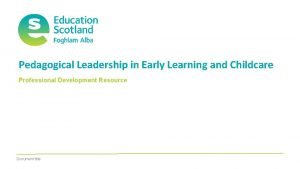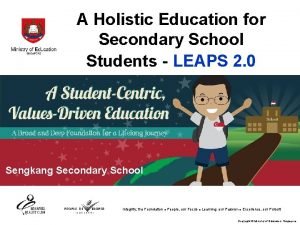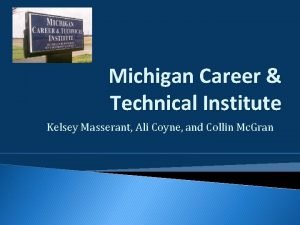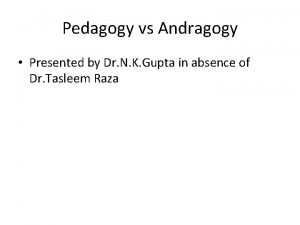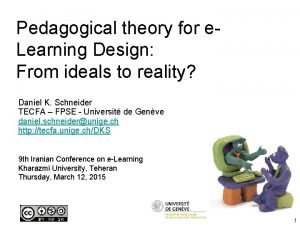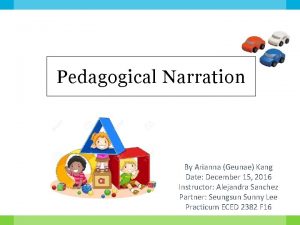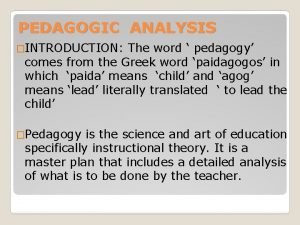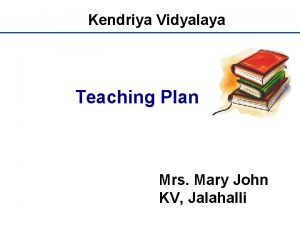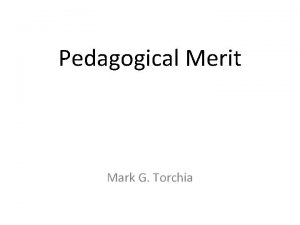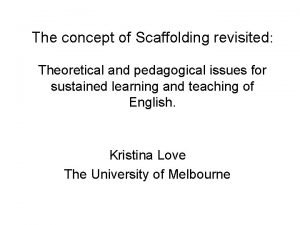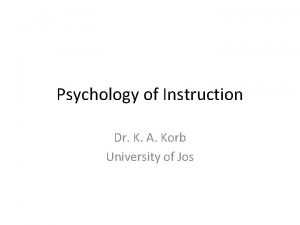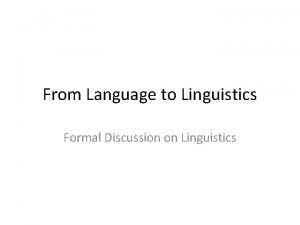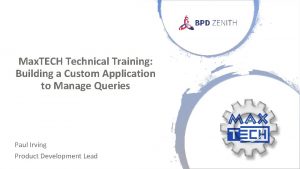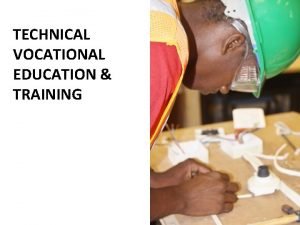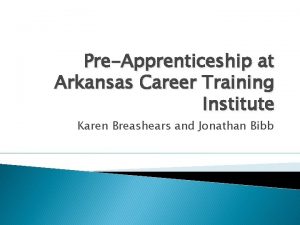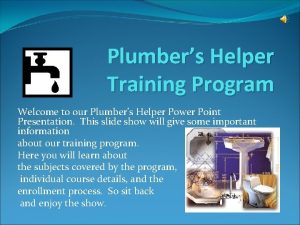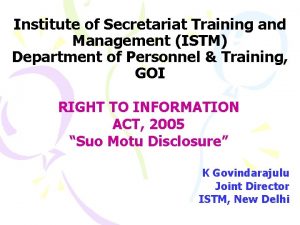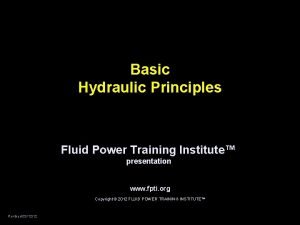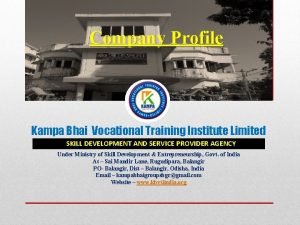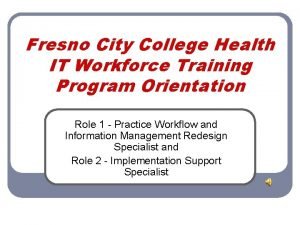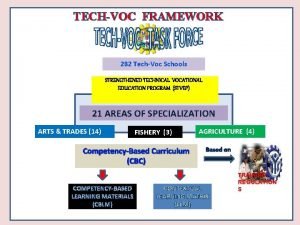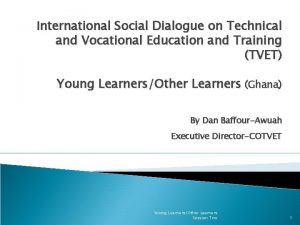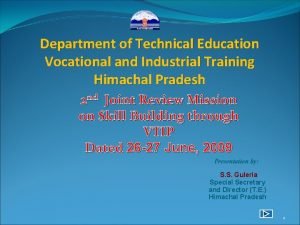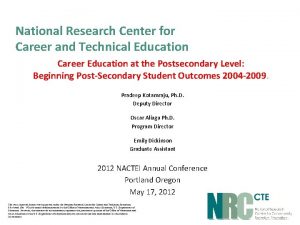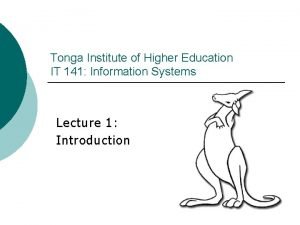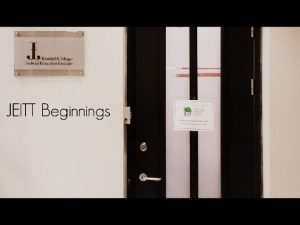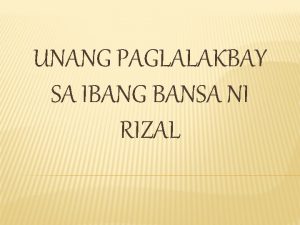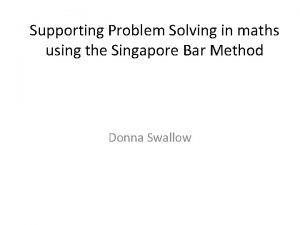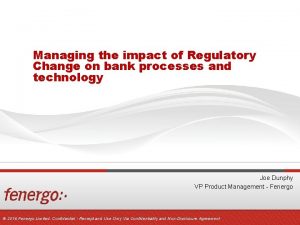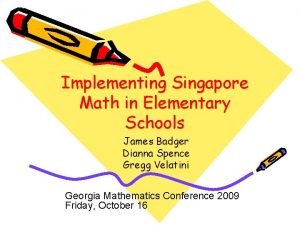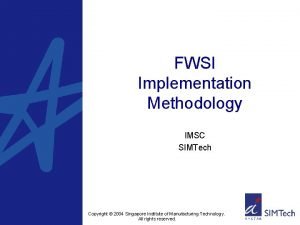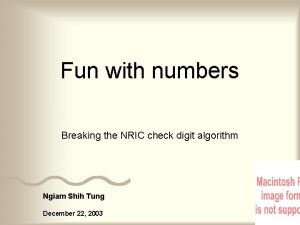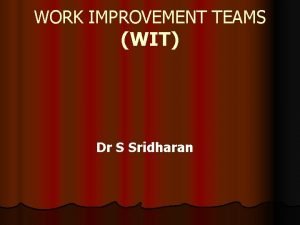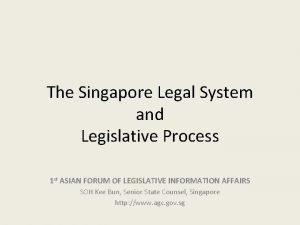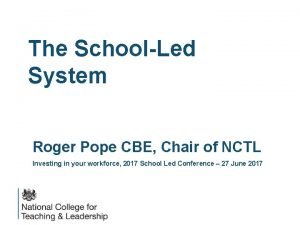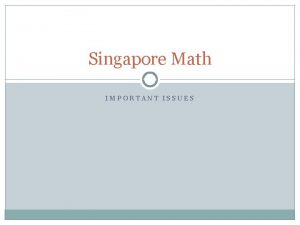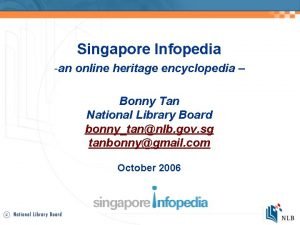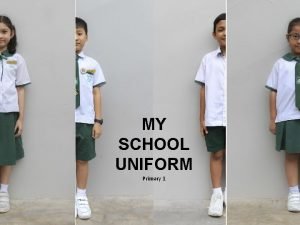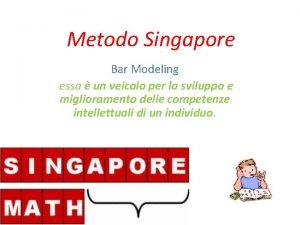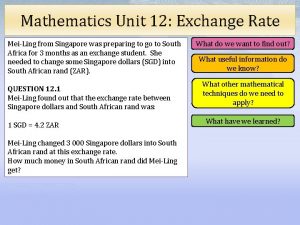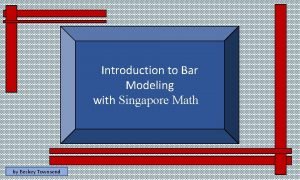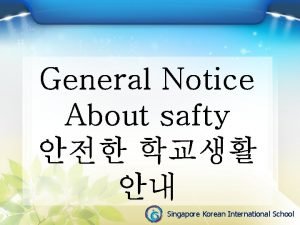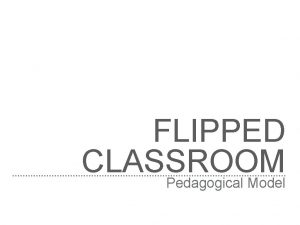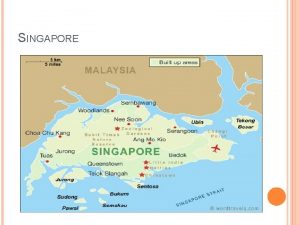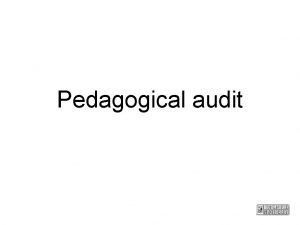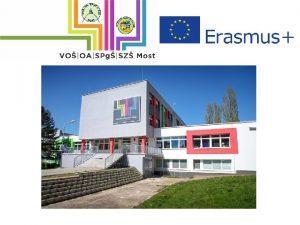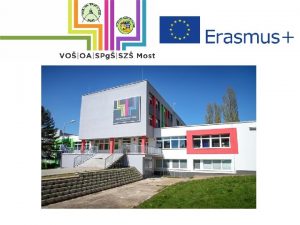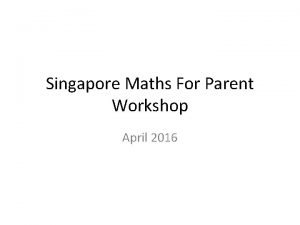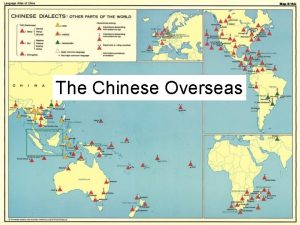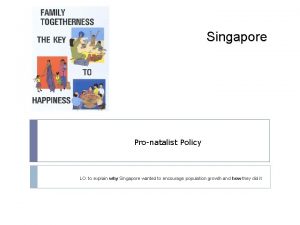Institute of Technical Education Singapore Pedagogical Training in















































































- Slides: 79

Institute of Technical Education, Singapore Pedagogical Training in Instructional Design & Facilitation for TVET Develop Competence. Based Instructional Plan (Learner Engagement Plan) Ms Joan Ling & Ms Faith Foo Instructional Design Specialist/ED Module 2 seowbl@ite. edu. sg & shalyn_s_h_tan@ite. edu. sg

2 Module Overview Develop Competence. Centric Instructional Plan Develop Instructional Blueprint Deliverable: An instructional blueprint based on a whole task from the competence based curriculum © 2011 Institute of Technical Education, Singapore Develop Learner Engagement Plan Deliverable: An instructional Plan for the whole task

3 Objective At the end of this topic, participants should be able to apply ITE Pedagogic Model to design a Competence-based instructional plan (Learner Engagement Plan) to teach a whole task © 2011 Institute of Technical Education, Singapore

4 What are the tasks to be covered? Develop Learner Engagement Plan Write context to situate learning Chunk & Sequence learning Design Teaching & learning strategies © 2011 Institute of Technical Education, Singapore Determine mode of delivery Determine duration of learning chunk Identify supporting resources & teaching aids 4

5 What is a Learner Engagement Plan (LEP)? q A plan with suggestions on how to prepare and conduct learning activities for a whole task (a unit of competency or part of a unit of competency). q Includes suggestions on: § Chunking of learning activities and duration for each chunk § Learning structure & sequence of learning activities § Delivery mode for each learning chunk § Strategies and specific instructions on how to carry out each activity § Supporting learning resources and/or tools for each activity q Specific instructional models (e. g. ITE Pedagogic Model) may be adopted to structure students’ acquisition of the whole task © 2011 Institute of Technical Education, Singapore 5

CHARACTERISTICS OF A WELL WRITTEN LEARNER ENGAGEMENT PLAN 6

7 Characteristics of a well written LEP Imagine you are grading a LEP designed by someone. What criteria will you apply to award the marks? q On your own, § think of a list of criteria you would apply. § write your criteria on slips of paper (one criterion on one slip). Do not show anyone. § upon signal from the facilitator, place your paper in the middle of the table. q In your group, § go through the criteria and group similar criteria, if necessary. § discuss and come up with a list of criteria your group would apply to grade a LEP § be prepared to explain the criteria and to describe the characteristics of an effective LEP to the class. © 2011 Institute of Technical Education, Singapore Strategy: Slip Writing 7

8 Characteristics of a well written LEP q Clear and concise q Suggestions are feasible and practical q Complete and self contained q Pedagogically sound q Support competence-based learning © 2011 Institute of Technical Education, Singapore 8

9 Characteristics of a well written LEP q Clear and concise q Suggestions are feasible and § Trainers using the LEP will have no problem interpreting the content practical § Minimise ambiguity q Complete and self contained q Pedagogically sound q Support competence-based learning © 2011 Institute of Technical Education, Singapore 9

10 Characteristics of a well written LEP q Clear and concise q Suggestions are feasible and practical q Complete and self contained § q Pedagogically sound q Support competence-based © 2011 Institute of Technical Education, Singapore Suggestions (strategies, learning sequence, resources/tools, duration, delivery mode) takes into consideration practical constraints at the institute, learning eg: time-table, resources availability, time availability, trainers’ capability, class size 10

11 Characteristics of a well written LEP q Clear and concise q Suggestions are feasible and § Suggested activities and coverage are adequate to ensure students master the competence(s) practical § q Complete and self contained q Pedagogically sound All supporting resources/tools are attached or information provided on where to get the resources/tools q Support competence-based learning © 2011 Institute of Technical Education, Singapore 11

12 Characteristics of a well written LEP q Clear and concise § Students’ characteristics (eg: ability, motivation, interest, prerequisite) are catered for. q Suggestions are feasible and practical § q Complete and self contained q Pedagogically sound Suggestions are effective in ensuring students’ mastery of the competence (s): ü make learning purposeful and meaningful ü ensure active participant & engagement q Support competence-based learning © 2011 Institute of Technical Education, Singapore 12

13 Characteristics of a well written LEP q Clear and concise § Supports integrated learning of TMS skills. § Situates learning in authentic q Suggestions are feasible and practical context, adopts authentic tools and work processes. q Complete and self contained § q Pedagogically sound Authentic tools, work processes, and/or encourages performance to authentic audience at authentic settings/environment. q Support competence-based learning § © 2011 Institute of Technical Education, Singapore Integrate flexible design that allows different modes of delivery and different paths. 13

14 Is this a well designed LEP? Study the given Learner Engagement Plan q On your own, take a stand on whether it is § Well-designed § Not well-designed § Part of it is well-designed q Go to the assigned location for your stand § Discuss with others with the same stand be prepared to justify your group’s stand Resources: Sample LEPs © 2011 Institute of Technical Education, Singapore Strategy: 3 corners 14

15 What you have just learnt… Develop Learner Engagement Plan Write context to situate learning Chunk & Sequence learning Design Teaching & learning strategies Determine mode of delivery Determine duration of learning chunk Identify supporting resources & teaching aids • Concept of LEP • Characteristics of good LEP © 2011 Institute of Technical Education, Singapore 15

RECAP INSTRUCTIONAL BLUEPRINT

17 Recap – What have you learnt in Topic 1? 1. What is an instructional blueprint? 2. What can you find in the instructional blueprint? 3. Will work sequence and learning sequence in the instructional blueprint be the same? 4. What are the 4 stages of the ITE pedagogic model? 5. What is the purpose of each stage of the model? © 2011 Institute of Technical Education, Singapore Strategy: Rally Robin

18 Recap – Instructional Blueprint 1 Sub-task 1 TK 2 6 Whole task Sub-task 2 TK 3 Sub-task 3 TK 4 Sub-task 4 TK 5 TK 6 TK 7 Broad St BS BS 3 4 © 2011 Institute of Technical Education, Singapore 5 BS 2 18

19 Recap – ITE Pedagogic Model m qu ire Re s me TASK tco Ou en ts How competent people perform tasks at workplace ITE Pedagogic Model Student As Novice PLAN EXPLORE PRACTISE PERFORM Student as Competent Performer & ENQUIRE REFLECT A Whole Competence Learning Approach in which students go through 4 phases (PEPP) to learn, with enquiry and reflection, how to perform a whole task competently © 2011 Institute of Technical Education, Singapore 19

20 A contextual view of competence Let’s recall and reflect – Concept of Competence Competent performance is By specifying a set of performance criteria associated with competent performance, we define the Skills Standard for the competence. Context and social Task Performance criteria An Integrated View A competence is a complex combination of skills, knowledge, attitudes and values required in the performance of a task. situated in contexts and social practices where personal and sociological practices competencies are used together with technical and methodological competencies to achieve job outcomes (professional competence) competence within organisational relationships and within broader relationships with industry and society Professional competence Technical Methodological Social & Ability to perform work at actual competence personal work situation competence Competence Knowledge Skills Ability to perform a workplace task Attitude & Values © 2011 Institute of Technical Education, Singapore 20

21 Let’s recall and reflect – Forms of learning Context and social practices B. Realistic/Authentic Task Performance criteria A. Integrated learning where learners engage in mastery of related skills, knowledge, attitudes and values as whole competences. learning where learners engage in active, socially participative learning in authentic, meaningful contexts organised around whole competences. Professional competence Technical Methodological Social & Ability to perform work at actual competence personal work situation competence Competence Knowledge Skills Ability to perform a workplace task Attitude & Values © 2011 Institute of Technical Education, Singapore C. Flexible learning where learners can use different ways to optimally learn and acquire the same competences. 21

22 Let’s Recall and Reflect Implications for social practices Context and B. Realistic/Authentic Learner Engagement Plan (LEP)learning where learners engage in active, socially participative learning in authentic, Task Performance • supports Integrated Learning of Technical , meaningful contexts Performance Methodological, Sociological competencies. organised around whole criteria competences. Ensure LEP A. Integrated Learning. where learners engage in mastery of related skills, knowledge, attitudes and values as whole competences. • situates Professional learning in authentic context, competence Technical Methodological Social & adopts authentic tools, work processes, Ability to perform work at actual competence personal and/or encourages performance to competence work situation authentic audience at authentic C. Flexible learning Competence settings/environments. Knowledge Skills where learners can use different ways to • integrate flexible design that allow different Ability perform a workplace task optimally learn and modes ofto delivery and different paths acquire the same Attitude & Values (types of activities) to achieve the samecompetences. learning outcome/objective. © 2011 Institute of Technical Education, Singapore 22

STRUCTURE OF LEP

24 Structure of Learner Engagement Plan Refer to the Instructional blueprint you have developed and LEP sample given to you in the previous activity: q Can you identify what are the elements in the LEP? q In a group, discuss what is the structure of LEP. Resources: Note_structure of LEP © 2011 Institute of Technical Education, Singapore Strategy: Group work

25 Structure of Learner Engagement Plan PLAN EXPLORE Make learning purposeful and meaningful PRACTICE PERFORM Empower independent performance and transfer Ensure active participation & engagement © 2011 Institute of Technical Education, Singapore

26 The Process… Develop Learner Engagement Plan Write context to situate learning Chunk & Sequence learning Design Teaching & learning strategies © 2011 Institute of Technical Education, Singapore Determine mode of delivery Determine duration of learning chunk Identify supporting resources & teaching aids

SITUATE LEARNING

28 Situate the learning q Why do we need to situate learning? § § Used to trigger and set learning within an authentic context Make learning meaningful to students Allow students to see the real life applications of the competence Facilitate transfer of learning to the actual work situation q What is an authentic context? § It is a scenario that mirrors or is likely to occur in the real work situation. © 2011 Institute of Technical Education, Singapore Strategy: Rally table

29 Situate the learning What makes a good authentic context? q In your own group discuss the question stated above q Write down your key points of discussion on a flip chart q Put your flip chart on the classroom walls q Walk around to see the points given by other groups q Clarify your doubts with the groups © 2011 Institute of Technical Education, Singapore Strategy: Gallery walk

30 Characteristics of good authentic context q Mirrors the real work situation q Task(s) to allow students to demonstrate their competence (i. e. to perform the whole task) is clearly described q Replicates the typical elements of the real world problem, situation or applications of the competence q Content and information required to help students plan their learning of the competence are embedded q Criteria and methods for assessing students’ competence are included q Presented in a manner that is meaningful and motivating to the students © 2011 Institute of Technical Education, Singapore

31 Characteristics of good authentic context q Mirrors the real work situation q Task(s) to allow students to demonstrate their competence (i. e. to the perform the whole task) isand clearly described Study given scenarios discuss in your group characteristics reflected inreal each scenario q the Replicates the typical elements of the world problem, situation or applications of the competence q Content and information required to help students plan their learning of the competence are embedded q Criteria and methods for assessing students’ competence are included q Presented in a manner that is meaningful and motivating to the students Resources: Note_scenario © 2011 Institute of Technical Education, Singapore Strategy: Discuss and share

32 Set context and situate learning There are 2 types of context: q Scenario based context Procedural based task Principle based task q Problem based context Principle based task © 2011 Institute of Technical Education, Singapore

33 Set context and situate learning There are 2 types of context: q Scenario based context -Showtask students the authentic Procedural based scenario -Present Principle based task issues, challenges in which skills and knowledge are likely to be used q Problem based context Principle based task © 2011 Institute of Technical Education, Singapore

34 Set context and situate learning There are 2 types of context: q Scenario In problem based learning, students are exposed to real life problem(s). They are to based context apply the skills and knowledge learnt to solve problem(s) presented in the context. Procedural based task The problem(s) presented should encourage Principle studentsbased to usetask analytical and decision making skills. q Problem based context Principle based task © 2011 Institute of Technical Education, Singapore

35 Practice: Set context and situate learning q On your own, determine whether to use scenario based or problem based context for your whole task. q Spend some time to think of a context and describe your context to your partner. q Offer suggestions to your partner’s context to improve. © 2011 Institute of Technical Education, Singapore Strategy: Peer check

36 Assignment: Create authentic context for learning q Using the template (softcopy), create an authentic context for learning. q Fill in the part on “Situating Learning”. q Bear in mind that this scenario will be given or described to students during the first lesson (or the Plan lesson in ITE Pedagogic Model) © 2011 Institute of Technical Education, Singapore Resource: Assignment template

CHUNK & SEQUENCE LEARNING

38 What you have just learnt… Develop Learner Engagement Plan Write context to situate learning Chunk & Sequence learning Design Teaching & learning strategies © 2011 Institute of Technical Education, Singapore Determine mode of delivery Determine duration of learning chunk Identify supporting resources & teaching aids

39 Place learning chunks in the LEP structure Transfer the learning chunks in the instructional blueprint to the LEP structure: q The first and the last row are for the whole task q From row 2 onwards, follow the sequence you have decided in the instructional blueprint © 2011 Institute of Technical Education, Singapore

40 What you have just learnt… Develop Learner Engagement Plan Write context to situate learning Chunk & Sequence learning Design Teaching & learning strategies © 2011 Institute of Technical Education, Singapore Determine mode of delivery Determine duration of learning chunk Identify supporting resources & teaching aids

DESIGN TEACHING & LEARNING STRATEGIES & DETERMINE MODE OF DELIVERY

42 Different ways to deliver a lesson These are the different ways to deliver a lesson: q Classroom based lesson § § Teacher facilitated Independent learning Teacher-centred Student-centred q Online learning § § Teacher facilitated Independent learning q Blended learning § § Teacher-centred Teacher facilitated Independent learning © 2011 Institute of Technical Education, Singapore Student-centred Strategy: Group discussion and present

43 Different ways to deliver a lesson These are the different ways to deliver a lesson: q Classroom based lesson § § Teacher facilitated Independent learning Resource based q Online learning § § Teacher facilitated Independent learning q Blended learning § § Teacher facilitated Independent learning © 2011 Institute of Technical Education, Singapore Strategy: Group discussion and present

44 Different ways to deliver a lesson These are the different ways to deliver a lesson: q Classroom based lesson § § Teacher facilitated Independent learning q Online learning § § Teacher facilitated Independent learning Collaborative activity q Blended learning § § Teacher facilitated Independent learning © 2011 Institute of Technical Education, Singapore Strategy: Group discussion and present

45 Different ways to deliver a lesson These are the different ways to deliver a lesson: q Classroom based lesson § § Teacher facilitated Independent learning q Online learning § § Teacher facilitated Independent learning Mode of delivery q Blended learning § § Teacher facilitated Independent learning © 2011 Institute of Technical Education, Singapore Strategy: Group discussion and present

46 Considerations to select mode of delivery q Is teacher-students, students – students interaction important? q Do the students have any prior knowledge of the content? q Is this the first or last lesson? q What is the nature of the content? q Are the students familiar with the technology? q How would you be checking the students learning progress? © 2011 Institute of Technical Education, Singapore

47 Considerations to select mode of delivery q Is teacher-students, students – students interaction important? q q Do the students have any prior knowledge of the If the content require students to interact content? with each other in order to learn (eg: show facial expression or voice tone) Is this the first or last lesson? then online learning or independent learning should not be used. What is the nature of the content? q Are the students familiar with the technology? q How would you be checking the students learning progress? q © 2011 Institute of Technical Education, Singapore

48 Considerations to select mode of delivery q Is teacher-students, students – students interaction important? q Do the students have any prior knowledge of the content? q Is this the first or last lesson? q What is the nature of Ifthe thecontent? students have no prior knowledge and the content is abstract, it may be Are the students familiar with better to the usetechnology? the teacher facilitated approach or blended approach so that How would you be checking the students the teacher can set alearning stage for learning progress? during the face to face session. q q © 2011 Institute of Technical Education, Singapore

49 Considerations to select mode of delivery q q Is teacher-students, students – students interaction For the 1 st lesson, or if it is the first time important? the trainer is meeting the students, faceto-face methods should be used so as to Do the students have anyallow priorthe knowledge of the trainer and students time to content? build rapport and be familiar with each other. Is this the first or last lesson? q What is the nature of the content? q Are the students familiar with the technology? q How would you be checking the students learning progress? q © 2011 Institute of Technical Education, Singapore

50 Considerations to select mode of delivery q q q Is teacher-students, students – students interaction If the content require simulation, or it important? cannot be carried out during the facesessions due of to the equipment Do the students have to-face any prior knowledge constrains, safety etc, then online content? learning may be a better choice. It will cut cost and allow students to try on Is this the first or last lesson? the machine without any risk. q What is the nature of the content? q Are the students familiar with the technology? q How would you be checking the students learning progress? © 2011 Institute of Technical Education, Singapore

51 Considerations to select mode of delivery q Is teacher-students, students – students interaction important? q q Do the students have any prior knowledge of the If the students have not been exposed content? to online learning, the teacher should then build it into the activity to start Is this the first or last lesson? them off this kind of learning before leaving them on their own What is the nature of the content? q Are the students familiar with the technology? q How would you be checking the students learning progress? q © 2011 Institute of Technical Education, Singapore

52 Considerations to select mode of delivery q Is teacher-students, students – students interaction important? q Do the students have any prior knowledge of the content? When you have decided to teach a q q series of lessons using online learning Is this the first or last or lesson? independent learning, it is important to have check points at different stages What is the nature of of thethe content? learning to monitor students progress. Ensure everyone follows Are the students familiar withbefore the technology? closely you loose them. How would you be checking the students learning progress? © 2011 Institute of Technical Education, Singapore

53 Recap – Characteristics of well written LEP q Clear and concise q Suggestions are feasible and practical q Complete and self contained q Pedagogically sound q Support competence-based learning © 2011 Institute of Technical Education, Singapore

54 Recap: Designing activities for ITE Pedagogic Model PLAN Activate prior knowledge/experience, if any. Trigger interest, set context for whole task. Inform expected performance & assessment criteria. Provide students with appreciation of whole task (broad overview) Guide students to arrive at the sub-tasks. Guide student to plan their learning of competence/whole task. Organise the class. Reflect on the planning. EXPLORE PRACTICE PERFORM Recap whole task & previous lesson Activate prior knowledge/ experience, if any. Trigger interest, set context (at the sub-task level) Inform objectives Recap whole task Recap the sub-tasks & assessment criteria & previous lesson Activate prior knowledge/ experience, if any. Trigger interest, set Provide opportunity for students to perform context (at the sub- the whole task level) Inform objectives Guide students to learn supporting knowledge and sub-task/skills (with lifeskills) Assess knowledge Get students to carry out sub-task, applying relevant supporting knowledge & lifeskills Assess sub-skills, if appropriate Reflect on learning. Conclude lesson (sub-task level) Reflect on their learning Conclude lesson (sub-task level) © 2011 Institute of Technical Education, Singapore Provide peer assessment or self assessment or teacher assessment opportunities (for the competence). Provide opportunities for students to reflect on their learning or performance of the whole task. Conclude, summarise, reinforce learning. Provide opportunities to transfer learning to a new context, if appropriate

55 Designing activities for LEP Design PLAN activities Design EXPLORE activities Design PRACTISE activities q Form groups of 4 (home group) q Number members 1 -- 4 © 2011 Institute of Technical Education, Singapore Design PERFORM activities 1 2 3 4 Strategy: Jig saw

56 Designing activities for LEP Design PLAN activities q Design EXPLORE activities Design PRACTISE activities 1 Form groups of 4 (home group) 1 q Number members 1 – 4 3 q q q Form experts groups Recall strategies you have experienced 3 Design PERFORM activities 1 2 2 Explore Plan 3 4 4 3 Practice Perform Enquiry Discuss how these strategies can be used in each of your assigned stage © 2011 Institute of Technical Education, Singapore 2 Strategy: Jig saw Reflect

57 Designing activities for LEP Design PLAN activities Design EXPLORE activities Design PRACTISE activities q Return to your home group q Each member takes turn to share the strategies identified and activities for the assigned stage to teach the whole task Design PERFORM activities 1 2 3 4 q Select a subtask from 1 of the whole task from your group members 1 2 3 4 q Design the activities in the subtask 1 2 3 4 q Present your design to the class © 2011 Institute of Technical Education, Singapore Strategy: Jig saw/gallery walk

58 Design consideration for the learning activities Learning activities should provide sufficient scaffolding to q encourage higher order thinking, preparing students to learn independently eventually. q help students acquiring the knowledge and skills in manageable chunks. q guide students to learn skills from simple to complex. © 2011 Institute of Technical Education, Singapore

DETERMINE DURATION OF LEARNING CHUNKS

60 Activity – Determine duration for the learning chunk How much time is needed for this learning chunk? q write down the time needed on a piece of paper q when the trainer says “Show”, show your time to the class © 2011 Institute of Technical Education, Singapore

61 Assignment: Design activities in each learning chunk q On your own, design the Plan, Explore, Practice and Perform activities in the LEP. q Remember to include Enquiry and Reflect activities for each stage, where appropriate. q Determine the mode of delivery and the duration of each learning chunk q Ensure the total number of hours in the LEP equals to the curriculum hours given for this whole task. q Find a partner, exchange, critique and offer suggestions to enhance each other’s activities. © 2011 Institute of Technical Education, Singapore

62 What you have just learnt… Develop Learner Engagement Plan Write context to situate learning Chunk & Sequence learning Design Teaching & learning strategies © 2011 Institute of Technical Education, Singapore Determine mode of delivery Determine duration of learning chunk Identify supporting resources & teaching aids

IDENTIFY SUPPORTING RESOURCES (LEARNING MATERIALS/RESOURCES)

64 Scaffolding Learning q What does it mean? Scaffolding is the provision of sufficient support to promote learning when concepts and skills are first taught to the students. Support: § Teacher § Learning materials – Print, technology (ICT) © 2011 Institute of Technical Education, Singapore Strategy: Group discussion

65 Types of learning resources q Print based resources q Digital based resources For classroom based lesson For online or blended lesson What are the print based resources available in your institution? What are the digital based resources available in your institution? © 2011 Institute of Technical Education, Singapore

66 Learning materials for classroom based lesson q Notes q Worksheet q Activity sheet Print based resources (documents in the learning material) q Jobsheet/Lab sheet © 2011 Institute of Technical Education, Singapore Strategy: Group work, gallery walk

67 Learning materials for classroom based lesson q Notes q Worksheet This is the compilation of the technical knowledge and information relevant to the tasks to be performed in this whole task. q Activity sheet q Job sheet/Lab sheet © 2011 Institute of Technical Education, Singapore 67

68 Learning materials for classroom based lesson q Notes q Worksheet q Activity sheet Worksheet contains exercises that will help students to reinforce learning or to check student’s understanding of technical knowledge needed in the whole task. q Job sheet/Lab sheet © 2011 Institute of Technical Education, Singapore 68

69 Learning materials for classroom based lesson q Notes q Worksheet q Activity sheet consists of a set of instructions that will guide students to carry out the activity in the learning chunk q Job sheet/Lab sheet © 2011 Institute of Technical Education, Singapore 69

70 Learning materials for classroom based lesson q Notes q Worksheet q Activity sheet q Job sheet/Lab sheet © 2011 Institute of Technical Education, Singapore Job sheet/Lab sheet provides instructions to guide students on how to carry out the task assigned in the workshop/laboratory, it may also includes instructions on how to operate the equipment and machines used 70

71 Learning materials for online & blended lesson q Learning objects, media objects q Presentations, documents (words, graphs, spreadsheet etc) q Graphics, animations, audio, video clips q Digital manipulatives, applets q Related websites © 2011 Institute of Technical Education, Singapore 71

TEACHING AIDS 72

73 Purpose of teaching aids q Support trainer’s ideas and improve audience understanding of the presentation q Adds variety to the presentation by giving the audience a break from listening and letting them see something q Illustrates complex ideas or concepts that are helpful in reinforcing trainer’s ideas © 2011 Institute of Technical Education, Singapore

74 Types of teaching aids q Whiteboards/Flip charts q Objects/Models q Flash cards, activity cards q Visualisers etc © 2011 Institute of Technical Education, Singapore

75 Select Teaching Aids -- What are the considerations? q Find a partner, discuss what are the considerations when you are selecting teaching aids? q Be ready to explain to the class your partner’s point. © 2011 Institute of Technical Education, Singapore Strategy: pair work

76 Select Teaching Aids -- What are the considerations? q Availability of the teaching aids -- is it easy to bring to the classroom? Is it easy to handle? q Size of object/model -- Too big to carry? Too small to see? q Size of audience – eg: using flip chart or whiteboard? © 2011 Institute of Technical Education, Singapore Strategy: pair work

Assignment: Select learning materials and teaching aids q On your own, select types of learning materials and teaching aids for your learning activities q Find a partner, exchange to check for completeness © 2011 Institute of Technical Education, Singapore Strategy: Pair work 77

78 What you have just learnt… Develop Learner Engagement Plan Write context to situate learning Chunk & Sequence learning Design Teaching & learning strategies © 2011 Institute of Technical Education, Singapore Determine mode of delivery Determine duration of learning chunk Identify supporting resources & teaching aids

79 Assignment Time!! q Continue with your assignment q Complete the following: § § § Write context Duration of each learning chunk Mode of delivery Teaching & learning strategies Learning materials and teaching aids Stages of each learning chunk © 2011 Institute of Technical Education, Singapore
 Kostanay state pedagogical institute
Kostanay state pedagogical institute Nukus state pedagogical institute
Nukus state pedagogical institute Pedagogical leadership in early childhood education
Pedagogical leadership in early childhood education Leaps singapore
Leaps singapore Singaren
Singaren Michigan career and technical institute
Michigan career and technical institute Kharkiv polytechnic institute
Kharkiv polytechnic institute Pedagogy vs andragogy
Pedagogy vs andragogy Pedagogical translation
Pedagogical translation Pedagogical theory
Pedagogical theory Narration table
Narration table Need and importance of pedagogical analysis
Need and importance of pedagogical analysis Lesson plan kvs bangalore region
Lesson plan kvs bangalore region Randstad pronunciation
Randstad pronunciation Pedagogical scaffolding
Pedagogical scaffolding Pedagogical approaches to teaching math
Pedagogical approaches to teaching math Teacher centered curriculum
Teacher centered curriculum Azerbaijan state pedagogical university
Azerbaijan state pedagogical university Synchronic and diachronic linguistics
Synchronic and diachronic linguistics Max technical training
Max technical training Technical and vocational meaning
Technical and vocational meaning Arkansas career training institute
Arkansas career training institute Free state training and development institute (fstdi)
Free state training and development institute (fstdi) Environmental training institute (eti)
Environmental training institute (eti) Helper plumber
Helper plumber Institute of secretariat training and management
Institute of secretariat training and management Effi barry training institute
Effi barry training institute Bidirectional variable displacement pump symbol
Bidirectional variable displacement pump symbol Strangulation training institute
Strangulation training institute Kampa bhai vocational training
Kampa bhai vocational training Green world group kolkata
Green world group kolkata Fresno city college orientation
Fresno city college orientation Definition of tech-voc
Definition of tech-voc Technical education dialogue
Technical education dialogue Technical education dialogue
Technical education dialogue Directorate of technical education karnataka
Directorate of technical education karnataka Director of technical education hp
Director of technical education hp Odisha technical education
Odisha technical education National research center for career and technical education
National research center for career and technical education Cteig grant
Cteig grant Tesol course uq
Tesol course uq Nj institute for continuing legal education
Nj institute for continuing legal education Tonga institute of higher education
Tonga institute of higher education Target institute of medical education and research
Target institute of medical education and research Judicial education institute of trinidad and tobago
Judicial education institute of trinidad and tobago Uga institute of higher education
Uga institute of higher education Reasons for singapore merger with malaysia
Reasons for singapore merger with malaysia Rick griffith
Rick griffith Paglalakbay ni rizal sa barcelona
Paglalakbay ni rizal sa barcelona Largest employer in singapore
Largest employer in singapore Singapore bar method
Singapore bar method Srfac singapore
Srfac singapore Fenergo singapore fatca
Fenergo singapore fatca Charles and keith marketing
Charles and keith marketing Algorithmic trading singapore
Algorithmic trading singapore Cashews clei
Cashews clei Singapore math tutorial
Singapore math tutorial Why did raffles choose singapore as a trading port
Why did raffles choose singapore as a trading port Student learning space password
Student learning space password Imsc singapore
Imsc singapore Nric last 4 digits
Nric last 4 digits Dintec singapore
Dintec singapore Optymyze singapore
Optymyze singapore Government type of singapore
Government type of singapore Axxa global
Axxa global Apollo leader vessel
Apollo leader vessel Iuiga blackhead remover
Iuiga blackhead remover Work improvement teams
Work improvement teams Law making process in singapore
Law making process in singapore Roger pope education
Roger pope education Howard shaw singapore
Howard shaw singapore Erp2 singapore
Erp2 singapore Singapore math concrete pictorial abstract
Singapore math concrete pictorial abstract Bonny tan
Bonny tan Pe attire
Pe attire Metodo singapore matematica
Metodo singapore matematica Mei-ling from singapore was preparing
Mei-ling from singapore was preparing Singapore maths bar model
Singapore maths bar model Korean school singapore
Korean school singapore Company confidential singapore
Company confidential singapore


